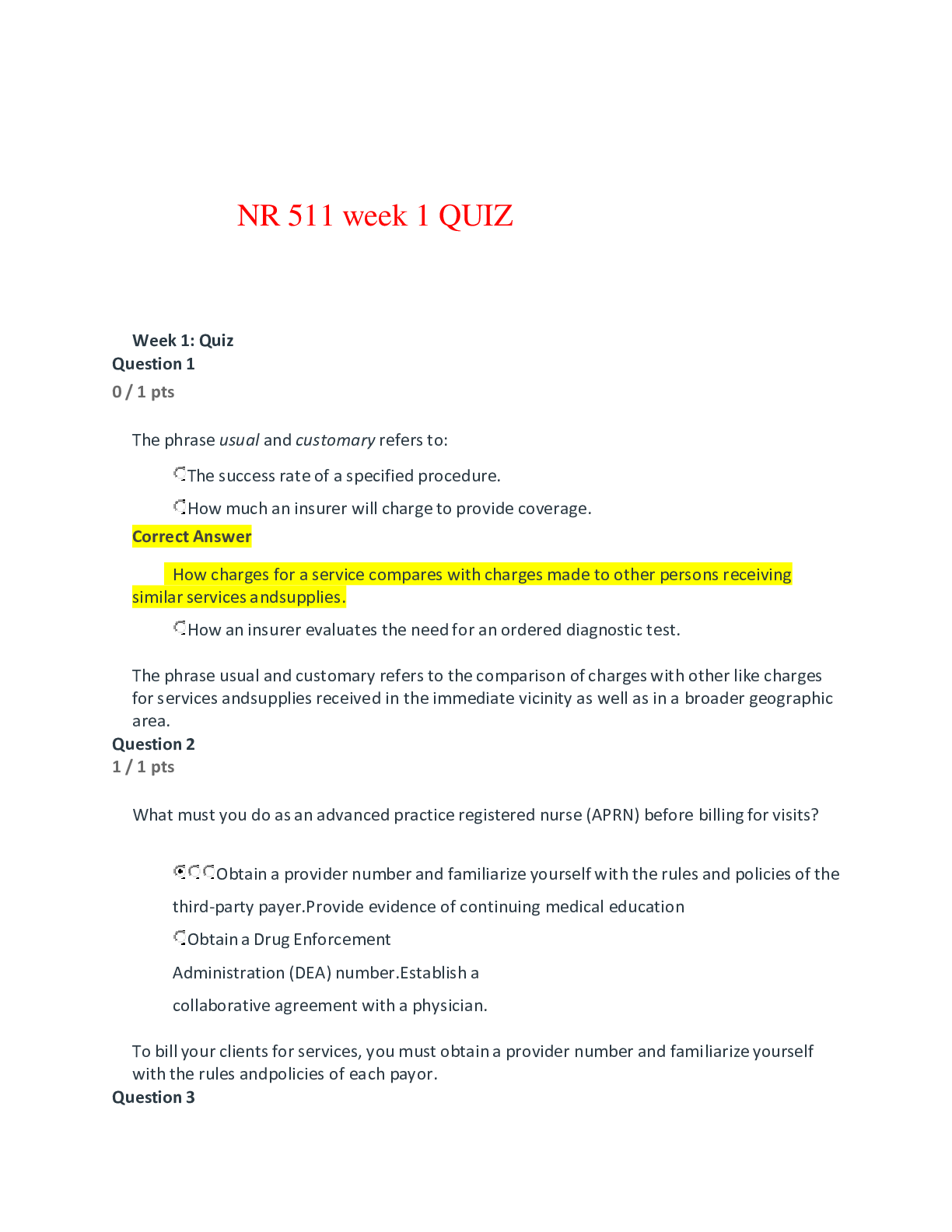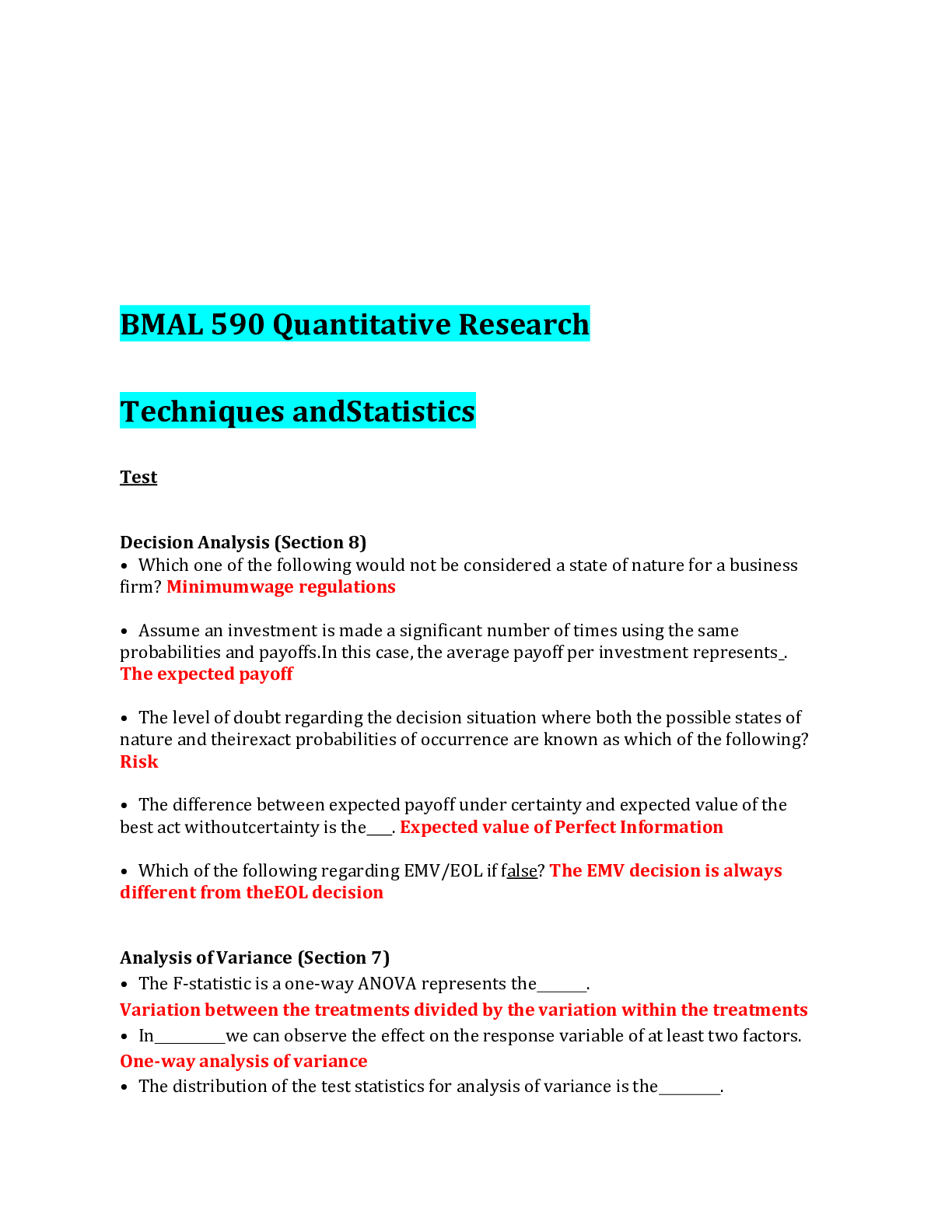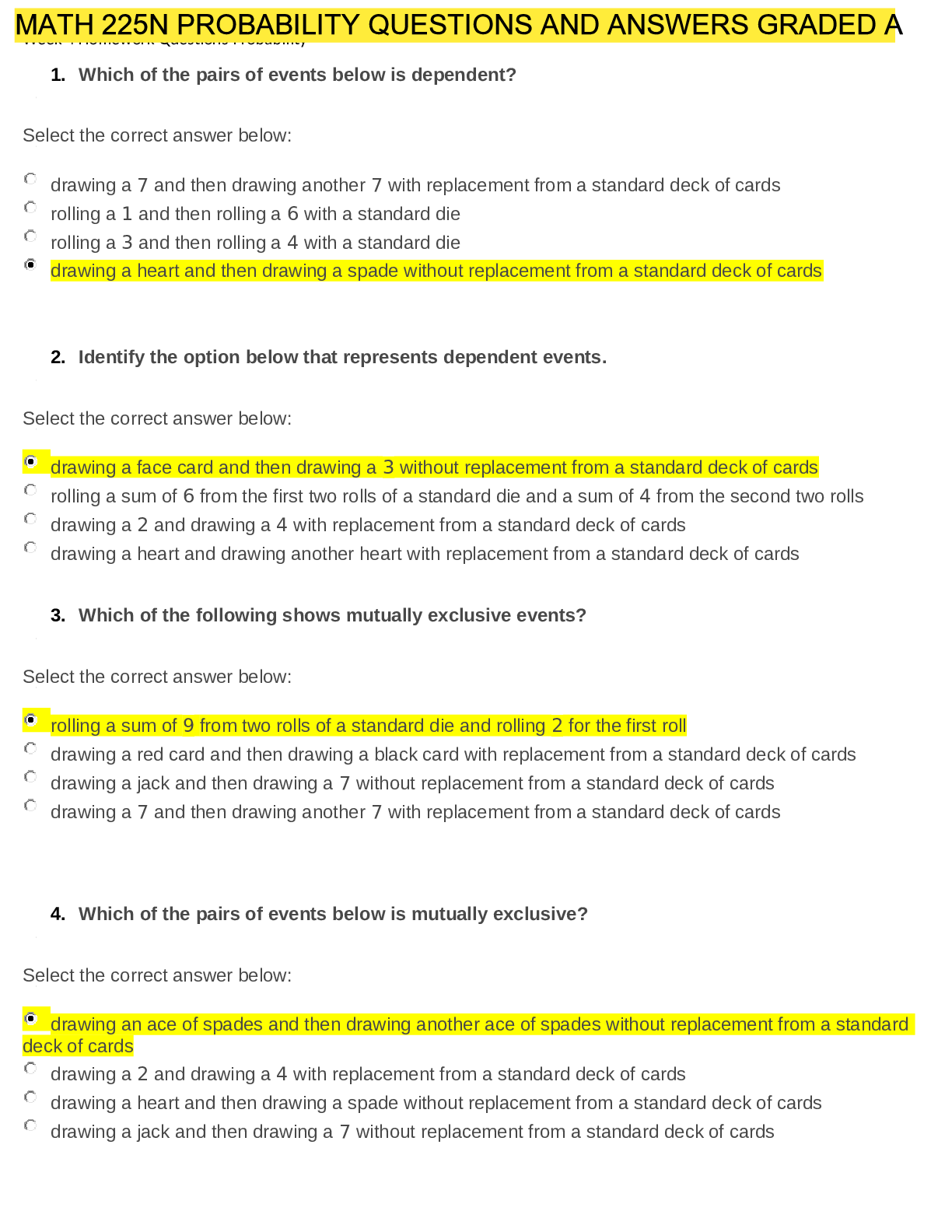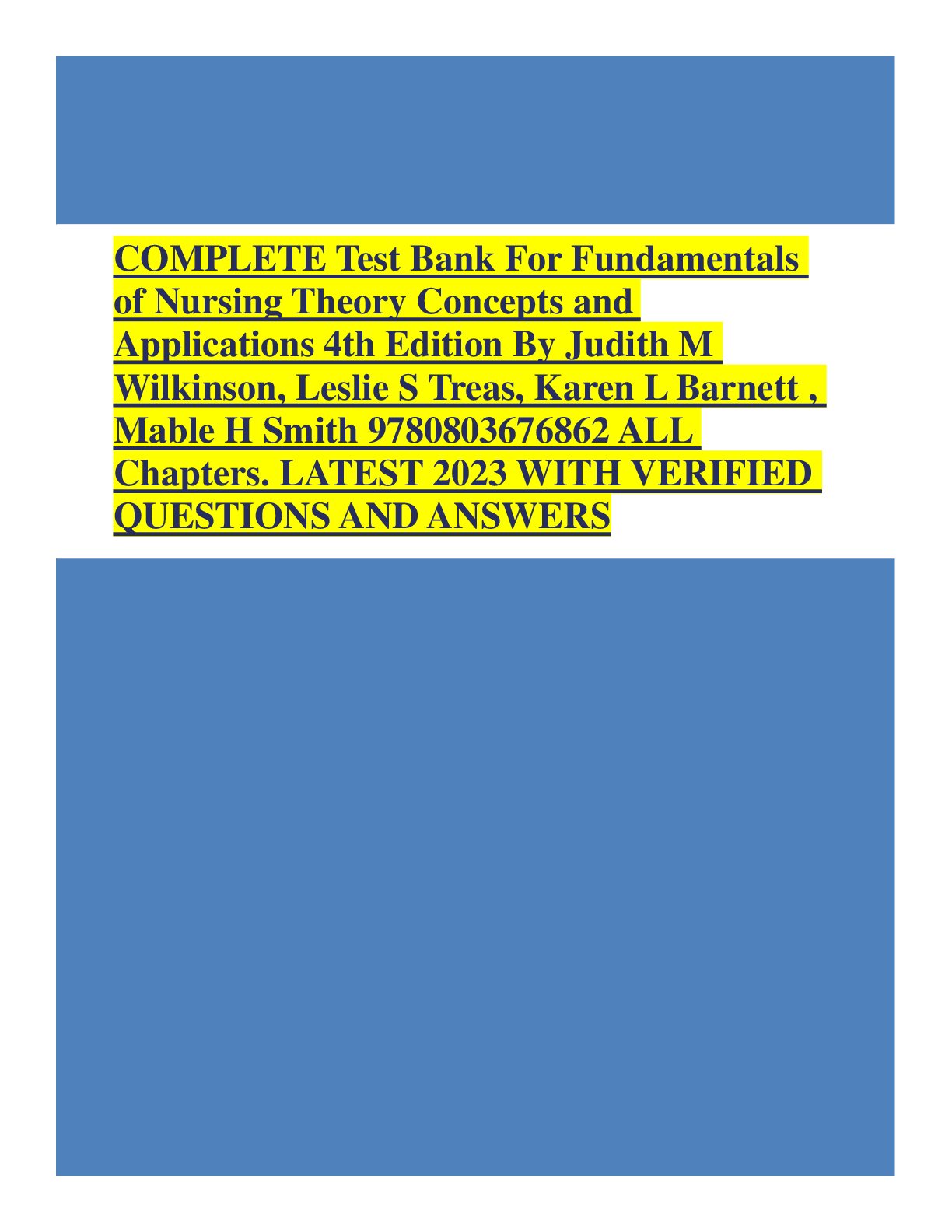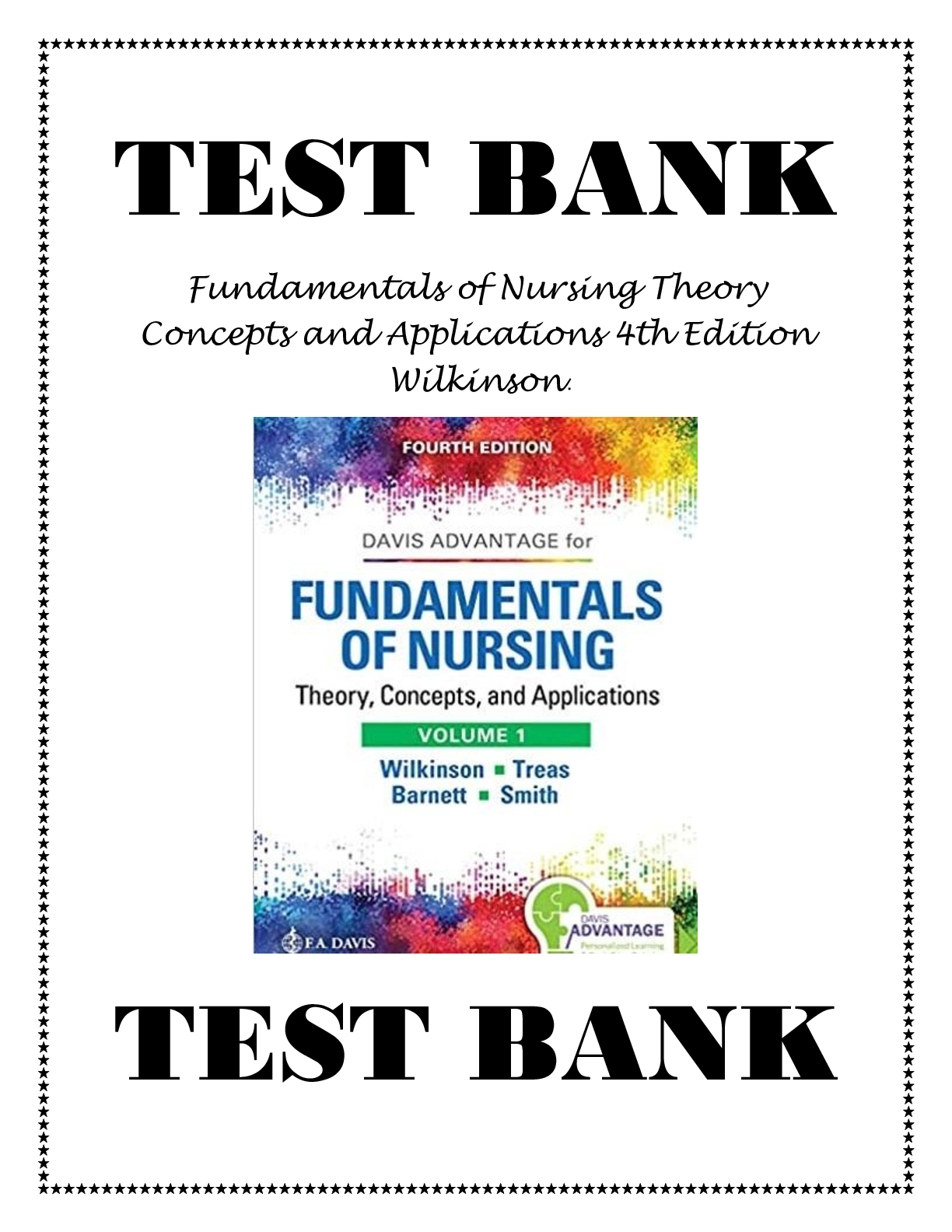Management > QUESTIONS & ANSWERS > Quantitative Analysis for Management, 11e (Render) Chapter 2 Probability Concepts and Applications (All)
Quantitative Analysis for Management, 11e (Render) Chapter 2 Probability Concepts and Applications
Document Content and Description Below
1) Subjective probability implies that we can measure the relative frequency of the values of the random variable. Answer: FALSE Diff: 2 Topic: FUNDAMENTAL CONCEPTS 2) The use of "expert opini... on" is one way to approximate subjective probability values. Answer: TRUE Diff: 1 Topic: FUNDAMENTAL CONCEPTS 3) Mutually exclusive events exist if only one of the events can occur on any one trial. Answer: TRUE Diff: 2 Topic: MUTUALLY EXCLUSIVE AND COLLECTIVELY EXHAUSTIVE EVENTS 4) Stating that two events are statistically independent means that the probability of one event occurring is independent of the probability of the other event having occurred. Answer: TRUE Diff: 2 Topic: STATISTICALLY INDEPENDENT EVENTS 5) Saying that a set of events is collectively exhaustive implies that one of the events must occur. Answer: TRUE Diff: 2 Topic: MUTUALLY EXCLUSIVE AND COLLECTIVELY EXHAUSTIVE EVENTS 6) Saying that a set of events is mutually exclusive and collectively exhaustive implies that one and only one of the events can occur on any trial. Answer: TRUE Diff: 2 Topic: MUTUALLY EXCLUSIVE AND COLLECTIVELY EXHAUSTIVE EVENTS 7) A posterior probability is a revised probability. Answer: TRUE Diff: 2 Topic: REVISING PROBABILITIES WITH BAYES' THEOREM 8) Bayes' theorem enables us to calculate the probability that one event takes place knowing that a second event has or has not taken place. Answer: TRUE Diff: 2 Topic: REVISING PROBABILITIES WITH BAYES' THEOREM 9) A probability density function is a mathematical way of describing Bayes' theorem. Answer: FALSE Diff: 2 Topic: PROBABILITY DISTRIBUTIONS 10) The probability, P, of any event or state of nature occurring is greater than or equal to 0 and less than or equal to 1. Answer: TRUE Diff: 1 Topic: FUNDAMENTAL CONCEPTS 11) A probability is a numerical statement about the chance that an event will occur. Answer: TRUE Diff: 1 Topic: INTRODUCTION 12) If two events are mutually exclusive, the probability of both events occurring is simply the sum of the individual probabilities. Answer: TRUE Diff: 2 Topic: MUTUALLY EXCLUSIVE AND COLLECTIVELY EXHAUSTIVE EVENTS 13) Given two statistically dependent events (A,B), the conditional probability of P(A|B) = P(B)/P(AB). Answer: FALSE Diff: 2 Topic: STATISTICALLY DEPENDENT EVENTS 14) Given two statistically independent events (A,B), the joint probability of P(AB) = P(A) + P(B). Answer: FALSE Diff: 2 Topic: STATISTICALLY INDEPENDENT EVENTS 15) Given three statistically independent events (A,B,C), the joint probability of P(ABC) = P(A) × P(B) × P(C). Answer: TRUE Diff: 2 Topic: STATISTICALLY INDEPENDENT EVENTS 16) Given two statistically independent events (A,B), the conditional probability P(A|B) = P(A). Answer: TRUE Diff: 2 Topic: STATISTICALLY INDEPENDENT EVENTS 17) Suppose that you enter a drawing by obtaining one of 20 tickets that have been distributed. By using the classical method, you can determine that the probability of your winning the drawing is 0.05. Answer: TRUE Diff: 2 Topic: FUNDAMENTAL CONCEPTS 18) Assume that you have a box containing five balls: two red and three white. You draw a ball two times, each time replacing the ball just drawn before drawing the next. The probability of drawing only one white ball is 0.20. Answer: FALSE Diff: 2 Topic: STATISTICALLY INDEPENDENT EVENTS AACSB: Analytic Skills 19) If we roll a single die twice, the probability that the sum of the dots showing on the two rolls equals four (4), is 1/6. Answer: FALSE Diff: 3 Topic: STATISTICALLY INDEPENDENT EVENTS AACSB: Analytic Skills 20) For two events A and B that are not mutually exclusive, the probability that either A or B will occur is P(A) × P(B) - P(A and B). Answer: FALSE Diff: 2 Topic: MUTUALLY EXCLUSIVE AND COLLECTIVELY EXHAUSTIVE EVENTS 21) If we flip a coin three times, the probability of getting three heads is 0.125. Answer: TRUE Diff: 2 Topic: STATISTICALLY INDEPENDENT EVENTS AACSB: Analytic Skills 22) Consider a standard 52-card deck of cards. The probability of drawing either a seven or a black card is 7/13. Answer: TRUE Diff: 2 Topic: MUTUALLY EXCLUSIVE AND COLLECTIVELY EXHAUSTIVE EVENTS AACSB: Analytic Skills 23) If a bucket has three black balls and seven green balls, and we draw balls without replacement, the probability of drawing a green ball is independent of the number of balls previously drawn. Answer: FALSE Diff: 2 Topic: STATISTICALLY DEPENDENT EVENTS 24) Assume that you have an urn containing 10 balls of the following description: 4 are white (W) and lettered (L) 2 are white (W) and numbered (N) 3 are yellow (Y) and lettered (L) 1 is yellow (Y) and numbered (N) If you draw a numbered ball (N), the probability that this ball is white (W) is 0.667. Answer: TRUE Diff: 2 Topic: STATISTICALLY DEPENDENT EVENTS AACSB: Analytic Skills 25) Assume that you have an urn containing 10 balls of the following description: 4 are white (W) and lettered (L) 2 are white (W) and numbered (N) 3 are yellow (Y) and lettered (L) 1 is yellow (Y) and numbered (N) If you draw a numbered ball (N), the probability that this ball is white (W) is 0.60. Answer: FALSE Diff: 2 Topic: STATISTICALLY DEPENDENT EVENTS AACSB: Analytic Skills 26) Assume that you have an urn containing 10 balls of the following description: 4 are white (W) and lettered (L) 2 are white (W) and numbered (N) 3 are yellow (Y) and lettered (L) 1 is yellow (Y) and numbered (N) If you draw a lettered ball (L), the probability that this ball is white (W) is 0.571. Answer: TRUE Diff: 2 Topic: STATISTICALLY DEPENDENT EVENTS AACSB: Analytic Skills 27) The joint probability of two or more independent events occurring is the sum of their marginal or simple probabilities. Answer: FALSE Diff: 2 Topic: STATISTICALLY INDEPENDENT EVENTS 28) The number of bad checks written at a local store is an example of a discrete random variable. Answer: TRUE Diff: 2 Topic: RANDOM VARIABLES AACSB: Reflective Thinking [Show More]
Last updated: 1 year ago
Preview 1 out of 28 pages
.png)
Buy this document to get the full access instantly
Instant Download Access after purchase
Add to cartInstant download
We Accept:

Reviews( 0 )
$15.00
Document information
Connected school, study & course
About the document
Uploaded On
Mar 23, 2021
Number of pages
28
Written in
Additional information
This document has been written for:
Uploaded
Mar 23, 2021
Downloads
0
Views
74

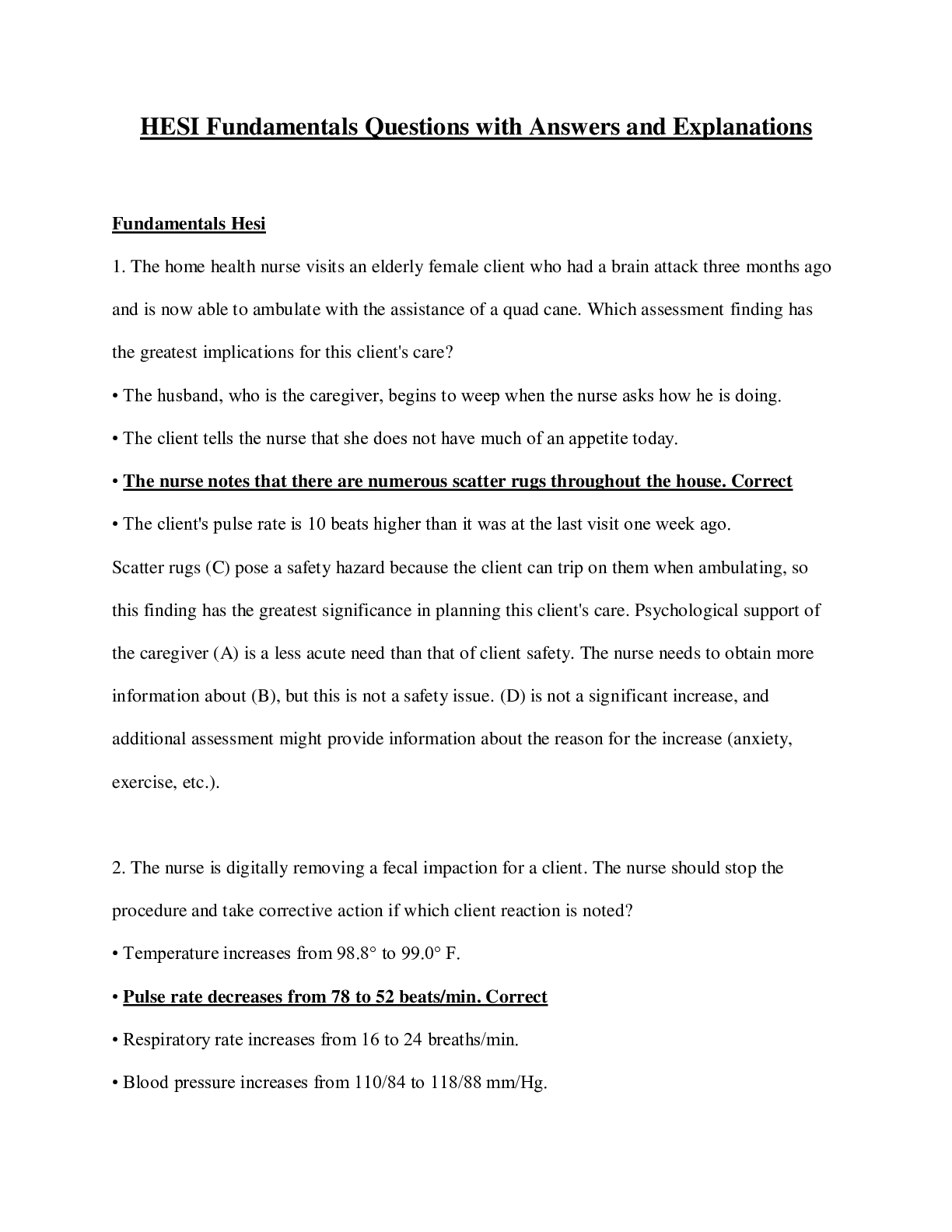
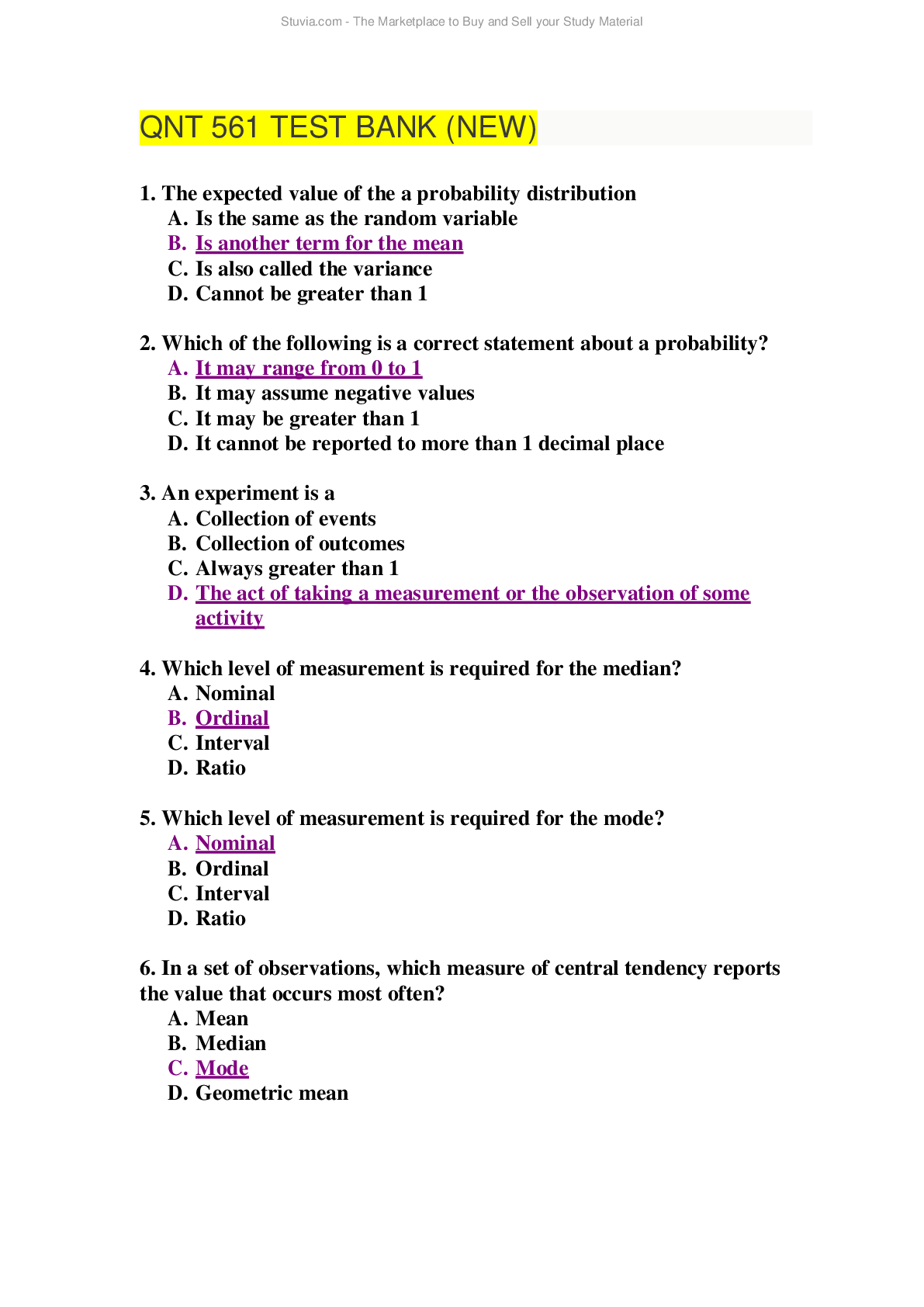



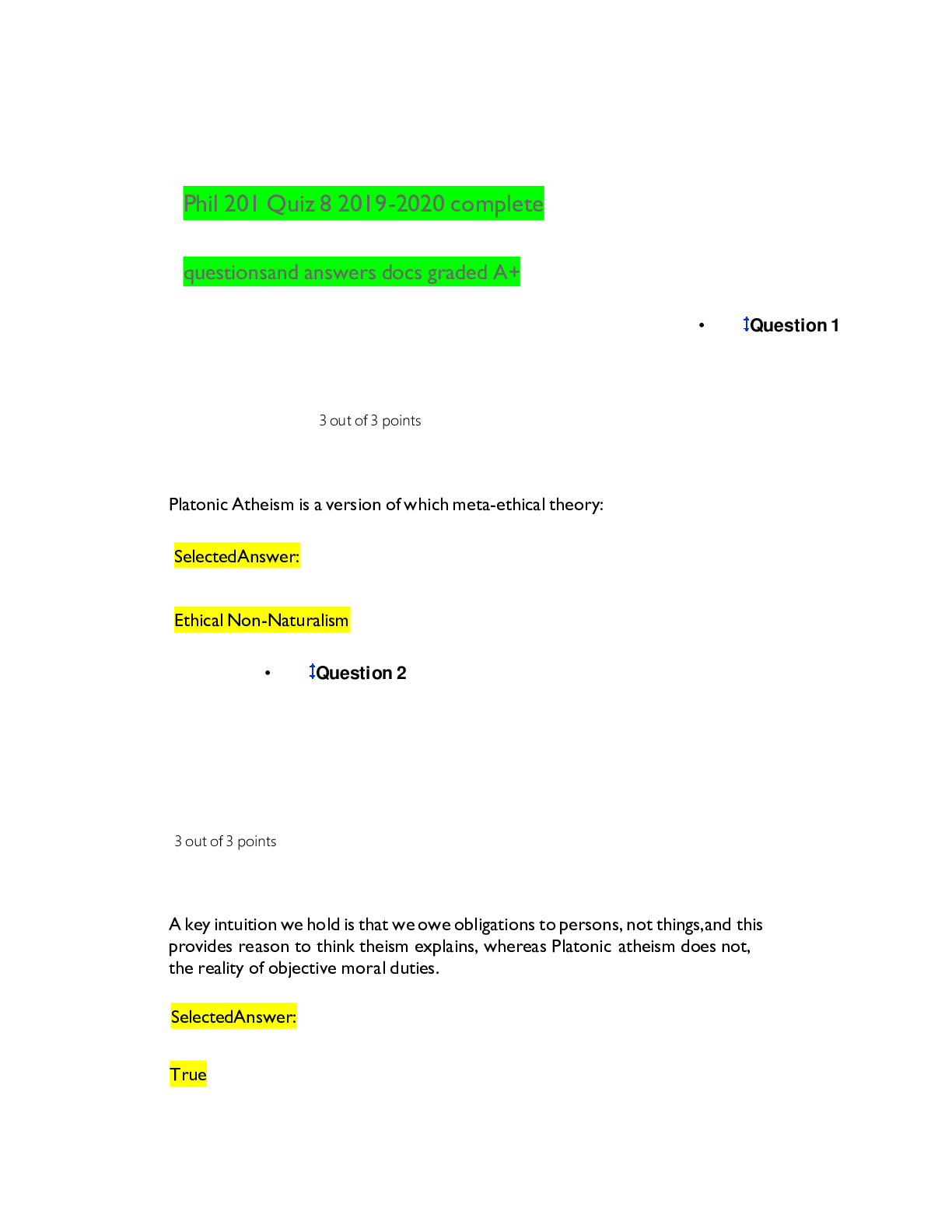
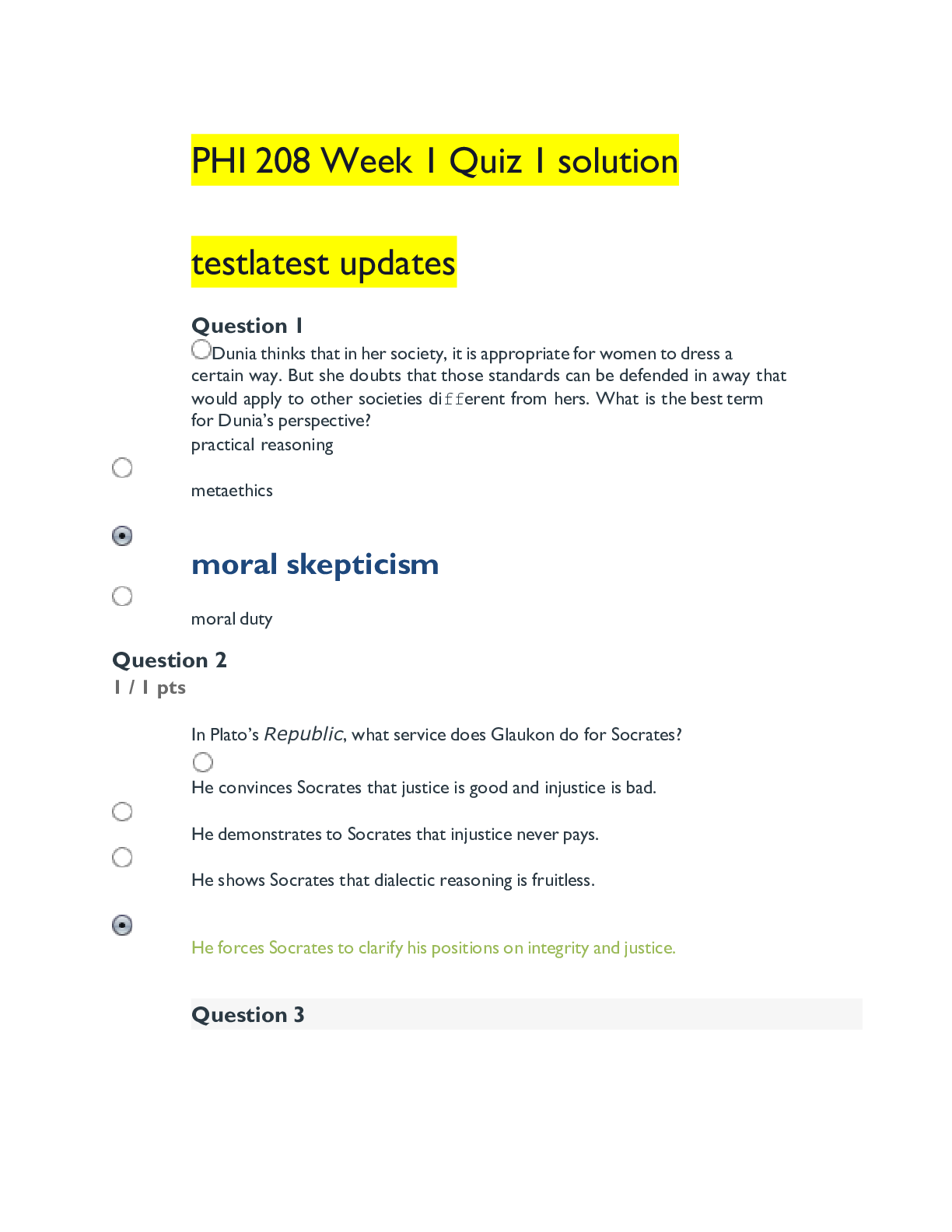
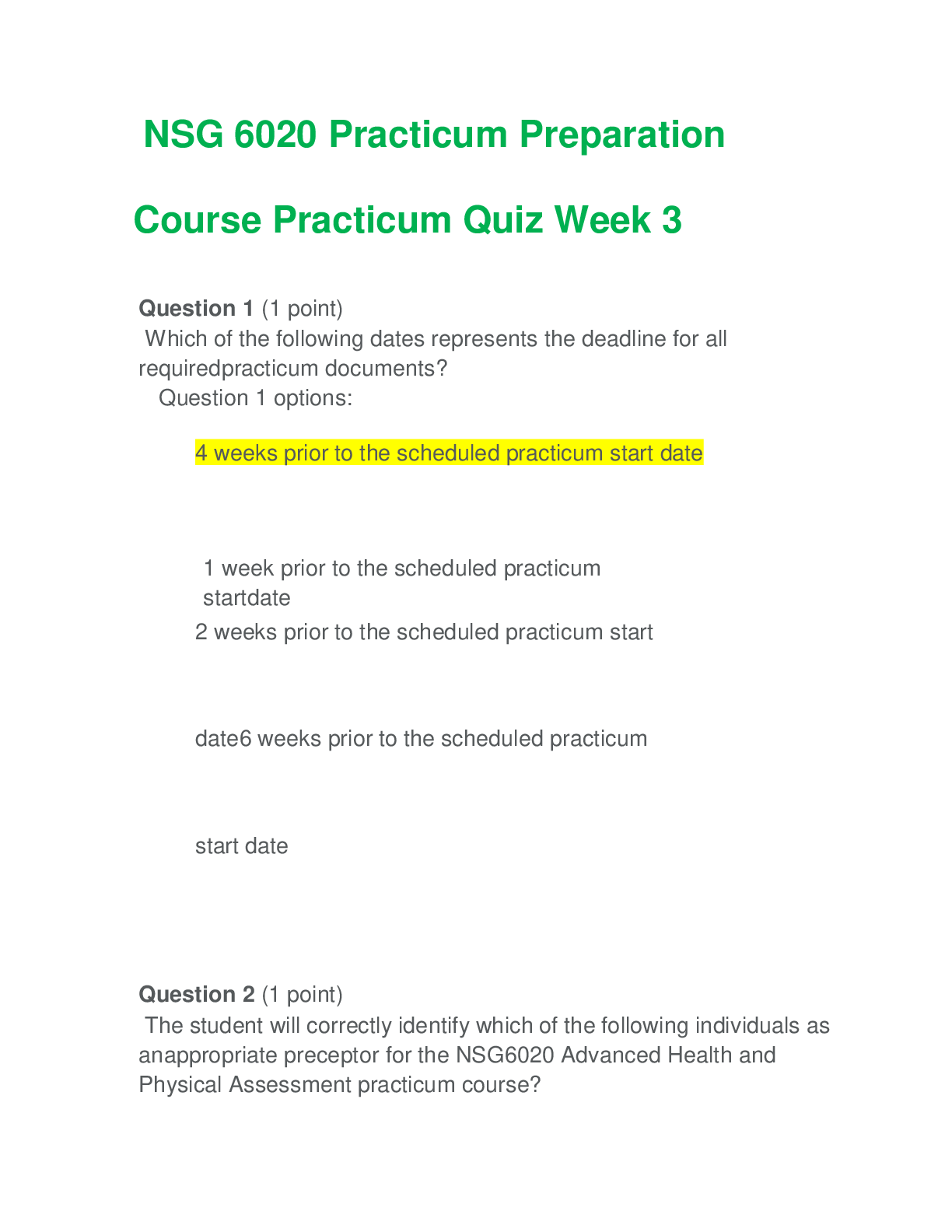
.png)

